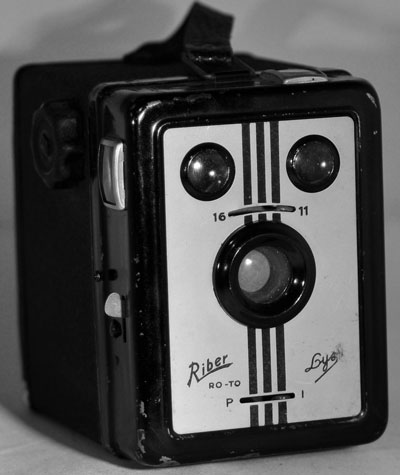Roto Riber Lys
Specification

| Manufacturer | : | Roto |
|---|---|---|
| Produced | : | 1950 |
| Classification | : | Medium Format |
| Body Type | : | Box |
| Construction | : | Metal |
| Film Type | : | 120 |
| Film width | : | 62mm |
| Image Size | : | 2¼ x 3¼ in |
| No. of Images | : | 8 |
| Lens Type | : | Meniscus |
| Focus Type | : | Fixed |
| Focal Length | : | 90mm |
| Focus Range | : | 3m to inf. |
| Aperture Type | : | Multihole |
| Aperture | : | f/11, f/16 |
| Shutter Type | : | Rotary |
| Shutter Speeds | : | B,I*(1/40 sec) |
| Size (w x h x d) | : | 75 x 100 x 108 mm |
| Weight | : | 288g |
| * Measured on this camera | ||
Art Deco Credentials
![]()
![]()
Acceptable: Modest and restricted
- Produced after the main Art Deco period;
- Geometric Art Deco front plate;
- Triple lines on front plate;
- Fine textured pattern on metal case;
- Triple embossed lines on metal back.
Description
This quite rare Italian Riber Lys box camera is an interesting addition to my collection. The front plate has a nice design with triple black lines down the front. The back and sides of the camera are metal with a rough finish. It has a leather handle on top. The camera is loaded by pressing two small buttons located on each side of the front to open it. The front and rear parts, however, remain attached by the handle.
This camera has typical controls for this era. The shutter can be operated in Instant(I) or Timed(P) mode. A small tab on the front can be used to switch from instant to timed. The aperture can be set by another tab to f/11 or f/16.
Film is advanced using a knob and the frame number is viewed through a red window on the back. The red window does not have a cover. It has two brilliant viewfinders for both landscape and portrait mode. There are no tripod mounts.
How to Use
This camera takes 120 film which is easily available. The red window should be covered with black tape except when winding on in low light.
As the shutter speed is only 1/40s, it is advisable to use a tripod to get clear shake free images. However, holding it against a wall or other solid object would work as well. For quick snapshots, hold it firmly against your body.
If you don't want to bother with an exposure meter, follow the guide shown. It is based on the 'Sunny 16' rule. Film is so forgiving and will produce acceptable results even when overexposed by 2 or 3 stops or underexposed by 1 stop.
The tables assume that the sun is at least 30 degrees above the horizon - that's 10am - 5pm on a summers day (May - August) in the UK.
Remember that the exposure guide in the manual may not be helpful as it is based on the use of old film with a low ISO value.
Using ISO 100/125 film - shutter speed 1/40s
| Weather Conditions | Shadow Detail | Aperture | Exposure |
|---|---|---|---|
 Sunny SunnySnow/Sand | Dark with sharp edges | f/16 | +2 Stops Overexposed Acceptable |
 Sunny Sunny | Distinct | f/16 | +1 Stop Overexposed Acceptable |
 Slight Overcast Slight Overcast | Soft around edges | f/16 | Good |
 Overcast Overcast | Barely visible | f/11 | Good |
 Heavy Overcast Heavy Overcast | None | f/11 | -1 Stop Underexposed Acceptable |
 Open Shade Open Shade/Sunset | None | f/11 | -2 Stops Underexposed Not Acceptable |